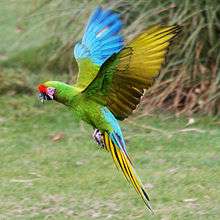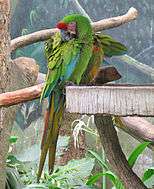Military macaw
| Military macaw | |
|---|---|
 | |
| A military macaw at the London Zoo. | |
| Scientific classification | |
| Kingdom: | Animalia |
| Phylum: | Chordata |
| Class: | Aves |
| Order: | Psittaciformes |
| Superfamily: | Psittacoidea |
| Family: | Psittacidae |
| Subfamily: | Arinae |
| Tribe: | Arini |
| Genus: | Ara |
| Species: | A. militaris |
| Binomial name | |
| Ara militaris (Linnaeus, 1766) | |
 | |
The military macaw (Ara militaris) is a large parrot and a medium-sized macaw. Though considered vulnerable as a wild species, it is still commonly found in the pet trade industry. It is found in the forests of Mexico and South America. It gets its name from its predominantly green plumage resembling a military parade uniform.
Taxonomy
There are three subspecies, A. m. militaris, A. m. mexicana, and A. m. boliviana. The differences between the subspecies are slight and pertain to minor variations in color and size, generally 70–80 cm (28–31 in), with the militaris subspecies being the smallest and the mexicana being the largest.
Description
The military macaw is 70.5 cm (27.8 in) long on average, 99–110 (33–43 in) across the wings and weighs 900–1,100 grams (2–2.4 lbs).[2] It is mostly green in color with the head a slightly paler shade. It bears a red frontal patch, with a white bare facial area barred with narrow black lines. The flight feathers are blue and the red tail bordered with blue. The large strong beak is grey-black and the iris yellow.[3]
The military macaw appears superficially similar to, and may easily be confused with the somewhat larger great green macaw.
Behavior
Military macaws live in large flocks and can live about 50–60 years in the wild. They can often be heard long before they are seen. They are a very noisy bird making a variety of loud cracking and shrieking sounds, including a loud kraa-aak.
Food and feeding
The military macaw's diet consists of seeds, fruits, nuts, berries, and other vegetation found on treetops in their forests. Their beaks are well adapted for eating various seeds and nuts as they have the ability to break open the hardest of shells with relative ease.
Military macaws will leave their roosts in flocks around dawn and head to their feeding areas. They will also visit heaps of clay known as “macaw licks”. These clay licks are found along riverbanks or sometimes in the interior of the Amazon rainforest. Macaws will flock to there to feed on these clay deposits, which appear to detoxify the poisons found in the seeds and vegetation of the rest of their diet. It is also thought that this clay provides the macaws with dietary salt not available in their normal diet.
Breeding
The three subspecies will breed at different times. However this probably has more to do with the geographical region they are residing in than anything else. Breeding in the militaris occurs from January to March. The mexicana breeds from April to July and the boliviana breeds in November and December. Military macaws are monogamous and remain with their mates for life. As they fly in large flocks the mates fly together. They will also be found flying in pairs in their feeding and roosting/nesting areas. Females will lay one to two eggs which only she will incubate for a period of approximately 26 days. Military macaws will reach sexual maturity in two to four years.
Distribution and habitat


The military macaw inhabits arid woodlands and subtropical forests. They typically live at elevations of 600 to 2600 m, higher in the mountains than most macaws ever range. However, these macaws may seasonally fly down to lowlands, where they are likely in humid forests and thorny woodlands.[2] They will nest in the tops of trees and more often in cliff-faces over 600 ft. (200 m) above the ground. The three subspecies of the military macaw are distinguished geographically. A. m. militaris are found in areas of Bolivia, Peru, Ecuador, Colombia, and Venezuela. A. m. mexicana occupy areas in Mexico and A. m. boliviana live in Bolivia and Argentina.
Conservation status
The population and distribution of the military macaw has been decreasing over the past fifty years. The abundance of the military macaw has now decreased to less than 10,000 globally. This decrease is mostly due to deforestation and the capturing of wild birds for the pet trade industry. Military macaws are now listed as vulnerable on the 2013 IUCN Red List Category. They are also listed as CITES (Convention on International Trade in Endangered Species of Wild Fauna and Flora) Appendix I, which protects the birds from being captured for trade.
Aviculture
When considering a military macaw as a pet, it is very important to verify the bird was bred in captivity. The U.S. Wild Bird Act forbids the commercial import of any bird listed by CITES. Though it is not among the most popular parrot species sought as a pet, the military macaw is often bred in captivity for trade and can be purchased for $800.00 to $1,000. The most common of the subspecies kept as pets is A. m. mexicana and they can live for more than 60 years in captivity.
Personality
Like most macaws, military macaws will be even tempered although sometimes they may be difficult and cranky. With proper training they can become a very tame and friendly pet. They are a very social bird who are playful and inquisitive and enjoy human interaction. Though they can be a noisy bird, they are very intelligent and have the ability to mimic human speech. They are considered to be a good choice for a show bird. When they get excited their face turns a pinkish reddish color similar in appearance to "blushing."
Diseases
Some common illnesses in pet military macaws include chlamydiosis, diarrhea, feather-plucking, and Proventricular Dilatation Disease. Swelling in the beak or eyes, eye or nasal discharge, loss of appetite, coughing, or lethargic activity are all warning signs of an ill pet.
Gallery

 Eating at Disney's Animal Kingdom, Florida
Eating at Disney's Animal Kingdom, Florida
 Resting in the Tropical Zone of the Montreal Biodome
Resting in the Tropical Zone of the Montreal Biodome- Cougar Mountain Zoo Issaquah, WA
References
- ↑ {{http://www.iucnredlist.org/details/22685548/0}}
- 1 2 "Military Macaw: Ara militaris". www.oiseaux-birds.com. Retrieved 17 March 2011.
- ↑ "Species factsheet: Ara militaris". BirdLife International (2008). Retrieved 24 July 2008.
External links
| Wikimedia Commons has media related to Ara militaris. |
- "Military Macaw." Minnesota Zoo. 2001. National Aviary. 9 Apr 2007 .
- "Military Macaw Care Sheet." Petco. 2005. PETCO Animal Supplies. 9 Apr 2007 .
- "Mexican Military Macaw." Animal Bytes. 2007. SeaWorld Inc.. 9 Apr 2007 .
- Girton, Vanessq. "Military Macaw." Bird Times Magazine. 2000. Pet Publishing Inc. 9 Apr 2007 .
- Brough, Clarice. "Military Macaw." Animal-World. Animal-World. 9 Apr 2007 .
